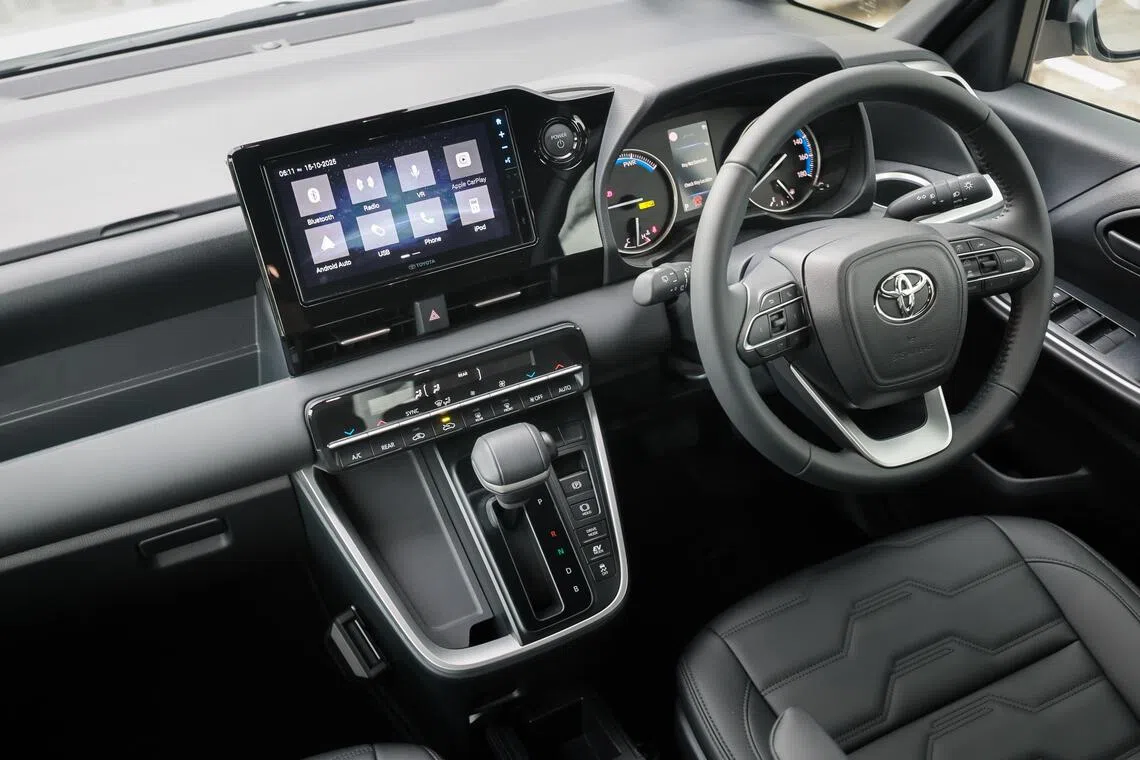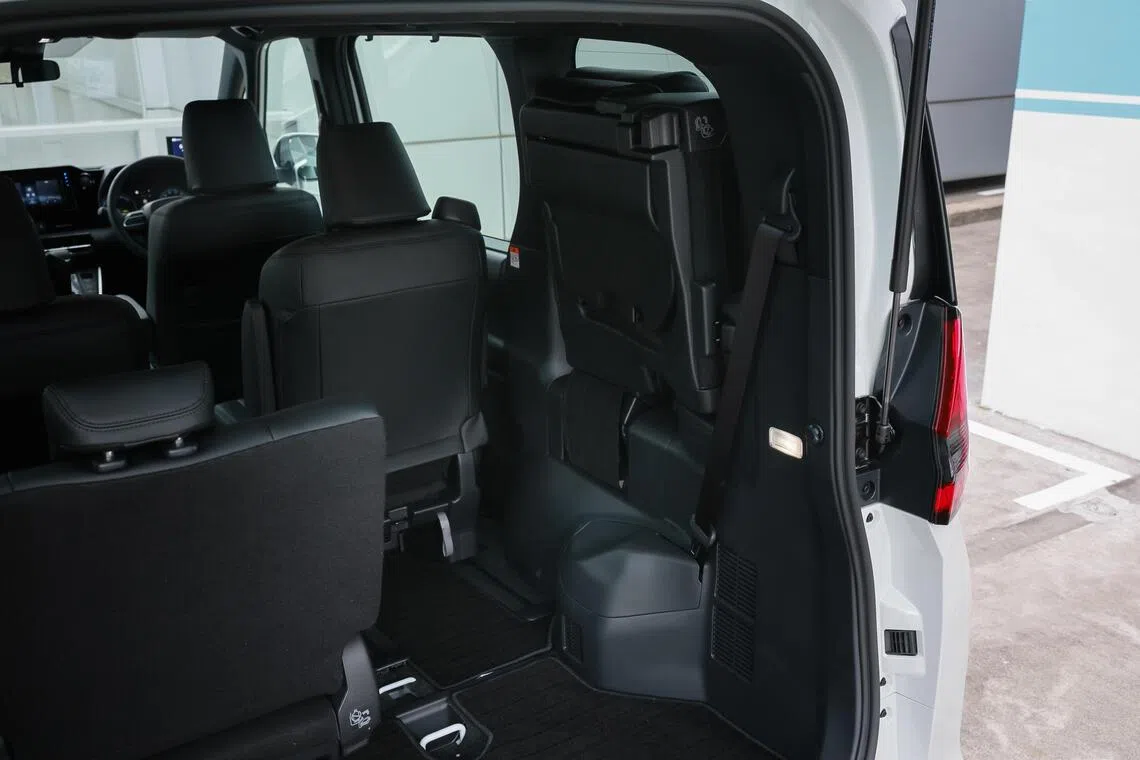Car review: Toyota Noah arrives after flood of demand
Sign up now: Get ST's newsletters delivered to your inbox
Follow topic:
SINGAPORE – Nearly three years after the Toyota Noah was launched in Japan, the mid-sized multi-seater is finally available in Singapore through its official distributor. Previously, the popular multipurpose vehicle (MPV) was brought in only through parallel importers who sourced them from dealers in Japan. Various versions of the Toyota Noah are sold in Singapore, including one badged as a Suzuki.
So strong is the demand for the Noah that when parallel importers here faced a delay in shipment earlier on, sales of its closest rival, the Nissan Serena, supposedly surged to pick up the slack.
Japanese carmakers, from Honda to Toyota and from Suzuki to Nissan, have a habit of keeping some models exclusively for their home market. Some of these Japan-only cars inadvertently end up being sold outside the home country by savvy parallel importers who spot their sales potential in Singapore.
When these models do succeed here, the local authorised dealer will lobby hard to offer them officially. Once in a while, the carmakers relent, which seems to be the case with the Noah.
The question is whether the Noah is still a relevant model today, or has Toyota missed the boat?
The official version looks similar to the Noah S-G edition sold in Japan. The front bumper is a bit fancier than the basic X version, which is available through some parallel importers here. The glossy black inlays and shiny chrome finishing are probably intended to make the car look more premium.
The brochure goes as far as describing the front-end design as bold and striking, complete with “16-inch aero rims” – referring to the alloy wheels, which are quite small by today’s standards.
The infotainment system has the usual features, including wireless connectivity to Apple CarPlay and Android Auto. Pairing the mobile phone to the system is easy. However, the video feed from the reverse camera can be better. The view is a bit distorted, and the colours are a bit faded, no matter how you adjust the display settings.

There is a physical switch for just about every essential control, which makes the cabin very easy to use.
ST PHOTO: GAVIN FOO

The rear bench can be folded to liberate more room for luggage.
ST PHOTO: GAVIN FOO
In any case, the Noah offers excellent all-round visibility for the driver, aided by usefully big wing mirrors and the nifty kerb view mirror. It is easy to reverse the car into and out of narrow spaces without having to rely too much on the parking camera.
Incidentally, some of the Noahs sold by parallel importers are fitted with larger and more elaborate touchscreens, although it is not known if these systems are any better.
Powering the Noah is a 96hp 1.8-litre petrol engine aided by an electric motor. Combined, the car has 138hp of power, which is adequate.
It can be driven electrically, but only for very short stretches, before the engine cuts in. There is an “EV Mode”, which will refrain from waking up the engine for as long as it can. However, push the accelerator beyond a certain point and the car reverts to the hybrid mode, with the engine and motor working together.
Mash the accelerator pedal further and the decibels climb exponentially. Go easy with the right foot and the overall refinement level is good.
Despite its block-like profile, the cabin is free from wind noise. The cushy suspension works well in the city, while being decently composed at higher speeds.
The Noah is remarkably fuel-efficient. It consumed petrol at the rate of 5.7 litres/100km during the 200km test drive, so a full tank of fuel should be good for more than 850km. Based on the average annual mileage of 16,400km, most Noah drivers will be visiting petrol stations no more than 20 times a year.
From the outside, the sliding doors can be opened either with the button on the door handles or by swinging a foot under the front door, particularly useful for a parent who has to carry a dozing toddler into a child seat.
The boot capacity is quite generous – enough to fit a couple of large suitcases standing up. The third-row bench is split in the middle and can be folded away to expand the boot. However, the rear hatch is not motorised, so it takes a bit of a stretch to close.
The combination of a low floor and ample headroom makes it easy to step in and out of the cabin. Folding away the table between the two individual chairs in the second row reveals a sizeable gangway to the third-row bench. Alternatively, the chairs can be tipped forward to allow access.
Legroom, even in the last row, is ample. And there are helpful air-conditioning vents on the ceiling, above the seats in the second and third rows.
The materials used throughout the cabin are more hardy than luxurious, which is well suited for a car like the Noah. The unyielding surfaces are easy to clean and seem tough enough to shrug off the kind of rugged use associated with families with young children who will eat, drink and occasionally throw up in the car.
There is a physical switch for every essential control that the driver will need, so there is no need to navigate the small infotainment screen. While the analogue dials may seem a bit dated against the digital readouts on many new cars today, they are also easier to read.
The Noah driving experience is stress-free, aided by its compact dimensions. While it may not look like it, the seven-seater, measuring 4,696mm from front to rear, is just 18mm longer than a Honda Civic. It is also 72mm narrower than the familiar four-door saloon, not that anyone can tell from the Noah’s spacious cabin.
It is the sheer efficiency of the Noah, both in terms of how it uses space and its petrol-hybrid powertrain, that makes this an MPV that is hard to beat.
Toyota Noah 1.8 Hybrid Elegance
Price: $246,888 with certificate of entitlement (COE) before discounts
Engine: 1,798cc, 16-valve, inline-4 cylinder
Transmission: CVT
Power: 96hp at 5,200rpm (138hp combined)
Torque: 142Nm at 3,600rpm
0-100kmh: 12.5 seconds (estimated)
Top speed: 160kmh
Fuel consumption: 4.4 litres/100km
Agent: Borneo Motors
Rating: ★★★☆☆
Comparable considerations
Nissan Serena ($269,276 with COE before discounts)
While the form of the Serena is practically identical to the Noah, the tech powering the Nissan is rather different. It is basically an electric car and the 1.5-litre engine only charges up the battery but does not turn the wheels directly. As such, the Nissan accelerates with more vigour than the Toyota, thanks to the high-torque characteristic of the electric motor.
BYD M6 ($265,388 with COE before discounts)
The profile of the BYD M6 is more car-like than the tall and slab-sided Noah. The lower roofline does compromise the ease of getting in and out of the car, but the electric car feels more dynamic to drive.
Maxus Mifa 7 ($258,999 with COE before discounts)
The electric Mifa 7 is quite a bit bigger than the Noah and the actual price premium over the Toyota is probably narrower than it looks after factoring in the discounts. The cabin is cavernous with more space than passengers will reasonably need.


